A Battlegames Special Guest Post by Sean Souter
Building desert terrain is thirsty work and no self-respecting collection of desert scenery is complete without a village well. A natural gathering place for friend and foe alike, one need only look at the Crusades to see the strategic importance of a reliable water source. As a centrepiece of a village or key objective in a battle, an artfully done village well is a straightforward addition to your table. (You can click on any of the images to see larger versions.)
We’ll let 3mm foam core do most of the work for us. This paper and foam sandwich is remarkably well suited to projects like this. To work effectively with foamcore, you need a sharp utility knife. Rather than snapping off pieces of blade constantly, I bought a sharpening stone and haven’t looked back since. Even the cheap metal of utility knives can be sharpened to a mirror finish with a ten-dollar 4000 grit miniature water stone. It works even better on the higher quality carbon steel blades that come with hobby knives. Overall, it probably doesn’t save any money, but there’s a lot to be said for always having a ‘new’ blade in every hobby knife you own.
The Base and Walls
I used styrene for a base because it’s thin, sturdy, easy to score and snap, and I know it won’t warp when I slather it in paint and glue. Cardboard from a cereal box or MDF will do the trick as well. Just make sure you seal it with a couple of light coats of PVA first. I used a Bolt Action blast template to draw the shape of the well and roughed up the surface of the styrene with coarse sandpaper to give a bit of ‘tooth’ for the glue to follow.
I’m sure there are many among you, and at least dozen websites, that can readily do the math to figure out how long a piece of foam core is needed to form the outside wall of the well. [Circumference = πD. So, a 50mm diameter well needs 3.14 x 50 = 157mm. Ed] I just used a piece of string and didn’t even need to count on my fingers. I wanted a well that was substantial but still in scale. The Perry Miniatures DAK figure is for reference—I figured three quarters of an inch high was about right.
With the correct width of a foamcore strip in hand, I scored it with a mostly retracted utility blade every quarter inch or so, just deep enough to completely cut the top layer of paper. Carefully snap each joint slightly by bending it and you’ll be left with a length of foam core that bends itself nicely into a near perfect circle. Glue the ends together with PVA, or whatever you’ve got that won’t melt foam, and leave it to bond.
The more observant readers will have noticed that part of the supplies for this project is a full tube of caulking. You can, of course, get by with a little tube of multipurpose glue, but I’m planning to knock out a dozen desert buildings in the next few months so I got the big tube of paintable brown caulking. If you barely nick the nozzle with a knife so only a tiny hole is opened and then use a piece of wire (like the brass wire used for pinning a model for example) to puncture the inner membrane, the stuff will dispense in a small bead and last you for months. Remember to wrap the tip in cling film between sessions.
You don’t even need a caulking gun. Just put an old medicine bottle or two in the end and push by hand. You’ll be amazed at how much control you’ve got over what comes out. It’s hard to beat paintable, flexible, strong, and low odour caulking for a job like this. You’ll also be doing yourself a favour if you get it in brown or tan so it blends in better. Make sure to fully secure all of the well to the surface with enough caulking to make it completely sealed. You’ll be thankful later if you pour two-part clear resin ‘water’ into the well.
Cut yourself a narrower strip of foam core and repeat the scoring process. This will be the animal drinking trough, so it should be roughly at a height that your pet pewter animals could drink from. I sized mine up with a Gripping Beast camel. Apply caulking and set it up the way you want it then lay a weight on top and leave it to fully cure. I happened to have a nice weighty tome close by on the part of my bookshelf reserved for frequently consulted volumes. It was just the thing…
Spackling or wall filler is the right stuff to smooth over the well wall. I always mix mine with a good blob of dark brown acrylic craft paint. First, this makes the spackle more liquid and gives a smoother coat. While we want surface detail, in 28mm thick jagged lines or spikes of rough spackle are out of scale. Even a really smooth coat of spackle leaves loads of detail that will pop out when dry brushed later. Second, if your wargames scenery gets chucked around at the club or show and is chipped or cracked, the damaged area will show up stark white unless you’ve coloured the spackle.
A quick blast of cheap spray paint will give glue something to stick to while also laying down an even colour over the larger surfaces.
The Water in the Well
Wells aren’t really worth fighting over unless they’ve got water in them. Paint the bottom of the well and trough to your liking. If you use a colour transition to add depth and interest to the water features, the graduations between colours should be smooth. There are many modeller’s potions that will do great looking water but, almost without exception, they are crystal clear and will show every brush stroke. In short, they won’t cover up a sloppy paint job, they’ll actually make it more noticeable. It was worth my time to break out the airbrush for this one, but a few judicious swipes with graduated colours of well thinned paint will achieve the same effect.
I’m a fan of Envirotex Lite for doing water. It pours nicely, doesn’t smell too much, and looks exactly like standing water when set. It also has the advantage that you can build it up in height, so it looks, and is, higher than the base of the model. You can, however, just use a couple of thick layers of clear gloss paint to give much the same look. If you used caulking to glue the well to the base you should have no problems. Oh yes, keep the container in which you mixed your batch of resin. I’ll tell you why shortly.
Clear resins do their job almost too well. They set perfectly flat and very shiny and look exactly like perfectly still standing water. To make things look more natural, you need a bit of chop or texture on the water’s surface. Once it sets, you can paint on a light coat of matte varnish, but the best way is to wait until the resin is almost set solid and then press a scouring pad onto the surface to give a touch of texture and tone down the shine. If you’ve kept the mixing container you used to brew up your batch of clear resin, you’ll know if it’s ready for texture when it’s hard but retains a bit of rubbery flex. That’s why you keep your mixing cup as a test sample, so you don’t have to test your main pour.
A quick note on colouring clear resin. A very small drop of ink or paint goes a long way. Start with a tiny amount, mix well, then evaluate. You can always add more but you can’t remove it once the colour is into the resin. Remember that clear ink will tint the water and leave it clear. Paint will colour the water but also make it cloudy and more opaque. Both have their uses depending on the desired end result.
Setting the Scene
I used balsa wood and coffee stir sticks, ‘donated’ by a big coffee chain, to build the partial cover for the well and the water bucket crane. Some natural coloured twine with watered-down PVA served to bind the pieces together and create a rustic looking system. Go ahead and chip, score, and scuff the balsa wood so it looks as battered as you like.
The beauty of using semi-porous materials like our darkened spackle, balsa wood, and twine is that they take washes beautifully. The washes progressively stain the absorbent materials with each successive application until you get a look that appears right to your eye. After drying, if it still looks right, give it all a good coat of matte varnish or watered down PVA to protect the surface. Then apply a light drybrush of a light, warm yellow.
I used my own mix of matte gel medium, fine brown grit, and more of that dark brown craft paint to coat the ground on the rest of the piece. Then, while it was all still a wet, mucky mess, I liberally sprinkled fine buff sand and allowed it all to set rock hard. Tap any remaining sand off the piece, add some tufts and foliage, perhaps a palm tree from the previous tutorial, and you’re good to go.
Now that’s a piece of terrain worth fighting over!
All content and images for this article ©Sean Souter 2018
Visit Sean’s website at https://onseanstable.com for more terrain tips and tutorials and tune in here for his regular guest posts.



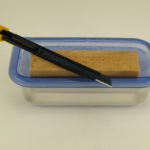
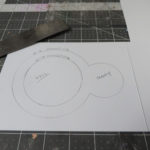
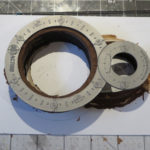
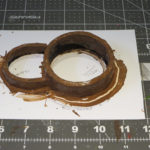
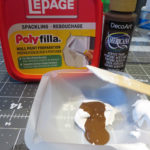

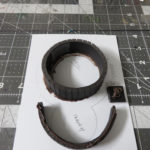
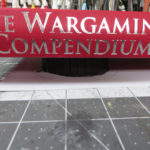
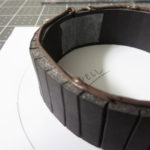
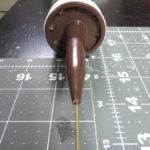

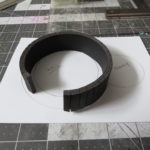
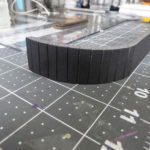
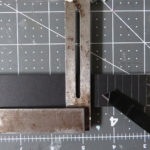
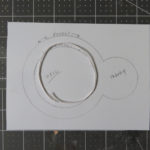
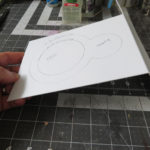

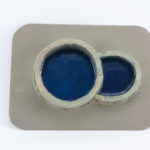
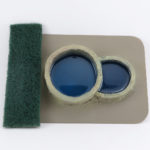
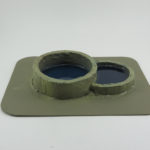
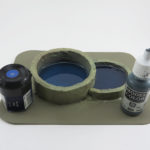

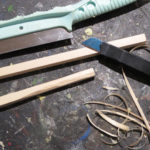
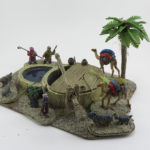
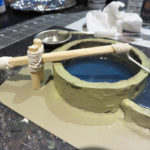

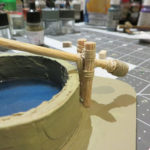

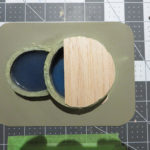
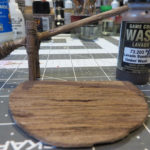
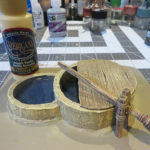
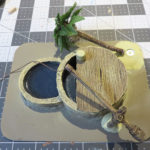
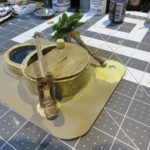

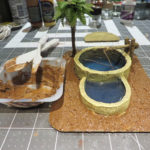
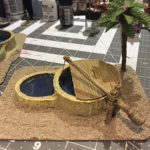
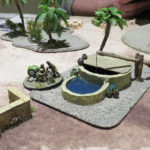

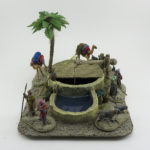
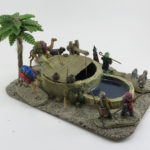

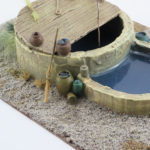
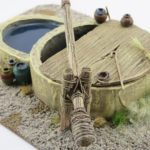
Thanks Lee, I agree. Tutorials will often offer at least a tip or two, even to veterans. I read all I can.
Very useful tutorial. Always good to read someone else’s techniques.
Thanks for stopping by, Lee. Sean certainly knows what he’s doing!